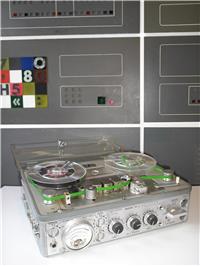Sound
The sound was recorded on an industry standard Nagra IV-L, an audio recorder introduced in 1968 by the Swiss-based Kudelski company. Occasionally a 1961-vintage Nagra 3 was used. When a film camera and an audio recorder are recording a scene they have to record at the same steady speed. Nagras are use their internal quartz clock to record a time signal on the magnetic tape. During playback, the pilottone ("neopilot") signal tells the Nagra about any speed variations, so it can play back at the original speed.
The Nagra can also record "wild", recording audio only. These audio "wild tracks" could be taken for peripheral dialogue and sound effects, or just to cover filmed scenes that had unwanted noises (footsteps or the heavy wooden doors sliding open, for instance).

The scene numbers on the sound recordings and clapperboards ("slates") are not the same as the script scene numbers. A continuity sheet was prepared mapping the two numbers for the editors.
The tapes were regularly reused by different productions at Pinewood. Some of the tapes had previously been used for The Zoo Gang; many of the tapes in Year 2 recorded over the sound of Year 1 episodes. After filming many of these tapes were discarded. Some of these have survived, but often the magnetic tape is fragile and degraded.
Copyright Simon Rhodes, Paul Stankevitch, Martin Willey